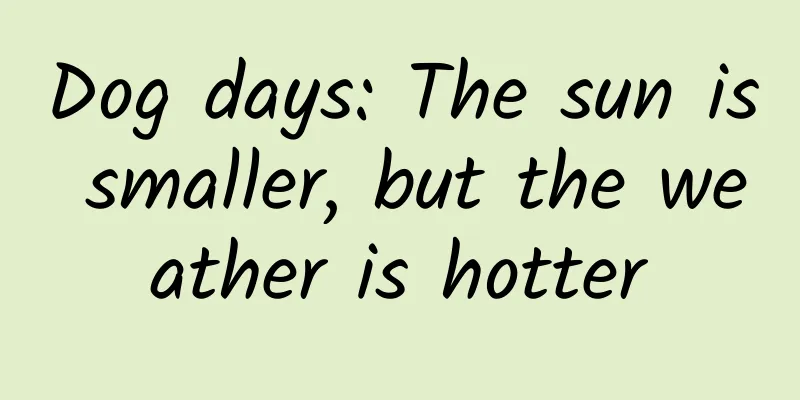Dog days: The sun is smaller, but the weather is hotter

|
As the saying goes, "train hard in the coldest days of winter and the hottest days of summer", the hottest days of the year are coming. What are the hottest days of the year? Why is it so hot during this period? Part 1 The dog days in the Chinese calendar In ancient my country, the "ganzhi calendar" was used, which used 60 different names formed by matching 10 heavenly stems (jia, yi, bing, ding, wu, ji, geng, xin, ren, gui) with 12 earthly branches (zi, chou, yin, mao, chen, si, wu, wei, shen, you, xu, hai) to record the year, month, day and time in a cycle. According to the traditional calendar, the third Geng day from the summer solstice is the first dog days, the fourth Geng day is the middle dog days, and the first Geng day after the beginning of autumn is the last dog days. This is the origin of the "three dog days". The dog days of summer usually start and end on the Geng day, and usually last for 30 or 40 days. The astronomical calendar shows that the first dog days of summer in 2022 will be on July 16, the second dog days on July 26, the third dog days on August 15, and the third dog days on August 24. This year, the dog days of summer total 40 days. Does this mean that this year will be hot for 40 days? What is the reason for the hot weather during the “dog days”? We may recall the scene in the famous article “Two Children Arguing About the Sun” in “Liezi·Tangwen”: When Confucius was traveling east, he saw two children arguing about the sun and asked them why. One child said, "I think the sun is closer to people when it first rises, and farther away when it is at its zenith." One child said, "I think the sun is far away when it first rises, but near when it is at its zenith." One child said, "When the sun first rises, it is as big as a car cover, but when it is at its highest point, it is as small as a plate or bowl. Isn't it because those that are far away are small, while those that are near are big?" One child said, "When the sun first rises, it is cold and dark, but when it is at its zenith, it is like dipping into hot water. Isn't it because those who are near are hot, while those who are far away are cold?" Confucius could not decide. The two children laughed and said, "Who knows more than you?" Is the heat during the dog days of summer really because the sun has become bigger or the earth is closer to the sun? Part 2 It's too hot, it doesn't matter how big the sun is In fact, the Sun is a middle-aged star in the main sequence stage. During this stage, the Sun burns stably and its volume changes very little. Therefore, the changes in the size of the Sun itself in a day or even a year are negligible. The radiation intensity of the sun is also very stable. Even though there are often sunspots and other solar activities on the surface of the sun, the variation in a year is only about 1%. Obviously, this is not the reason for the hot summer days. Could it be that the Earth was closer to the Sun during this period? The relationship between the 24 solar terms and the Earth's orbit Source: drawn by the author No. In fact, the distance between the sun and the earth is farther than usual during this period. The orbit of the earth around the sun is not a perfect circle, but an ellipse with an eccentricity of 0.0167. The average distance between the Sun and the Earth is about 149.6 million kilometers. The distance at aphelion is 152.1 million kilometers, and the distance at perihelion is 147.1 million kilometers. Aphelion is about 5 million kilometers farther than perihelion, which is 1/30 of the average distance. The Earth passes the aphelion in its orbit in early July and the perihelion in early January, so the distance between the Sun and the Earth is farther than the average during the dog days of summer. "The farther away, the smaller; the nearer, the bigger." This year, the Earth reached its aphelion at 15:11 Beijing time on July 4. The sun in the dog days is actually a "small sun" rather than a "big sun." The solar radiation caused by the change in distance is relatively reduced by about 6%, which is obviously not the cause of the dog days. In addition, the elliptical orbit also leads to the unevenness of the annual apparent motion of the sun. The earth's speed is slowest when it passes through the aphelion point and fastest when it passes through the perihelion point. The length of the interval between seasons is also unequal. For example, a total of 178 days, 20 hours, and 12 minutes will pass from the Autumnal Equinox in 2021 to the Spring Equinox in 2022, while a total of 186 days, 9 hours, and 31 minutes will pass from the Spring Equinox in 2022 to the Autumnal Equinox in 2022. In addition, summer in the Northern Hemisphere is also longer than winter. Part 3 The cause of the hot summer in the dog days of summer has been found To answer the question about the heat during the “dog days”, we need to understand the reasons for the change of seasons. The root of all this lies in the characteristics of the Earth's orbit. While the Earth revolves around the Sun, it also rotates around its axis. The orbital plane of the Earth's revolution around the Sun is called the ecliptic plane, and the plane passing through the center of the Earth and perpendicular to the Earth's axis is called the equatorial plane. These two planes currently have an angle of 23°26′, which is called the ecliptic-equatorial angle. It is the existence of this angle that causes the sun's direct point to move between 23°26′ north and south latitude on Earth throughout the year as the Earth is in different positions in its orbit. When the sun reaches 23°26′ north latitude (Tropic of Cancer), it is called the summer solstice; when it reaches 23°26′ south latitude (Tropic of Capricorn), it is the winter solstice; and when it reaches the equator, it is the vernal/autumnal equinox. Schematic diagram of solar radiation during the summer solstice Source: Drawn by the author During the summer solstice, the sun is at a high altitude in the northern hemisphere during the day, and the sunshine time is long. Taking Nanjing as an example, on the summer solstice, the sun's altitude at noon is about 82 degrees, and the daytime duration is 14 hours and 15 minutes. Compared with the winter solstice, the sun's altitude at noon is about 35 degrees, and the daytime is only 10 hours and 4 minutes long. Therefore, the solar radiation energy received per unit area on the summer solstice is the highest, about three times that of the winter solstice, and the higher the latitude, the greater the ratio. The amount of solar radiation received is the main reason for the change of seasons. The sun's position in four seasons captured at the same time of day Source: Science Popularization China - Scientific Principles at a Glance However, the hottest time in the Northern Hemisphere is not the summer solstice, but the period after the summer solstice, because the change in temperature is also affected by the balance of heat on the surface. Generally, for a period of time after the summer solstice, the heat absorbed by the ground is still greater than the heat it releases, and the ground temperature continues to rise. This period of time corresponds almost exactly to the "three hot days" in the traditional calendar, thus creating the "three hot days" heat in the northern hemisphere. After that, the heat released by the ground is greater than the heat absorbed by the ground, and the temperature gradually drops. Of course, for some local areas, atmospheric circulation, differences in land and sea, terrain factors, weather conditions, etc. are all factors that affect the temperature, and the hottest time does not necessarily correspond to the "dog days" date. By the way, how do you beat the heat? Editor: Wang Tingting Produced by: Science Popularization China Produced by: Wang Kechao (Purple Mountain Observatory, Chinese Academy of Sciences) Producer: China Science Expo The article only represents the author's views and does not represent the position of China Science Expo This article was first published in China Science Expo (kepubolan) Please indicate the source of the public account when reprinting Please indicate the source of the reprint. Reprinting without authorization is prohibited. For reprint authorization, cooperation, and submission matters, please contact [email protected] |
<<: Why are we building a telescope in Antarctica?
>>: Gunfire, bullets and armor: the enchanting "assassin" of Nanki Shirahama, Japan
Recommend
The efficacy and function of green orchid
There are so many medicinal herbs in the world, a...
The efficacy and function of ground tendons
We know that there are many kinds of Chinese medi...
Many people know about the "West-East Gas Transmission Project", but this time it is the "West-East Hydrogen Transmission Project"
Jiang Yue On July 3, the survey and design of the...
New AI image processing method! Tsinghua team proposes a method for generating “high-resolution” images
In the hot field of "AI image generation&quo...
The efficacy and function of Potentilla alba
Potentilla alba is a very nutritious and precious...
Failure + delay, where will Europe's launch vehicle go?
Recently, the European Space Agency announced the...
What are the effects and functions of dog whip
I wonder if you have a scientific understanding o...
The efficacy and function of cowhide
We know that there are many kinds of Chinese medi...
Dislocated joints due to yawning, broken bones due to going to toilet, why are contemporary college students so "fragile"?
Audit expert: Wu Xinsheng Deputy Chief Physician ...
The efficacy, function and edible method of mulberry leaves
Mulberry leaves are very common in our life. Mulb...
The efficacy and function of yellow peel
Huangpi has the effects of digesting food, reduci...
Side effects of Pudilan
Pueraria lobata can clear away heat, detoxify and...
The efficacy and function of Chinese medicine Pyrola
There are many types of Chinese medicine, and dif...
What is the Northeast Cold Vortex?
"It started snowing again in April", &q...
Have you gained weight after the Spring Festival feast?
Gaining weight in just seven days From New Year&#...









